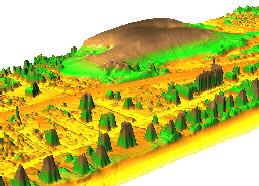GRASS GIS 7.0.0 RC1
GRASS GIS 7.0.0 RC1
We are pleased to announce the first release candidate of the upcoming GRASS GIS 7.0.0 version

What’s new in a nutshell
The graphical user interface based on wxPython has been enriched with many new features in order to make complex GIS operations available as simple as possible. The old Tcl/Tk based GUI has been dropped. Relevant new features are available in the core system, among the most important the new Python interface to the C library. This new feature permits Python developers to create new modules in a simple way while at the same time creating powerful and fast modules. Furthermore, the vector library was particularly improved to make it faster and more efficient with support of huge files. This required a easy to manage topology format update including a new spatial index. A lot of effort has been invested to standardize parameter and flag names. Finally, there are a series of new modules to analyse raster and vector data; some of the already existing modules were improved and made faster (some even 1000 x faster). For details see below.
The first release candidate GRASS GIS 7.0.0RC1 ships 10,400 fixes and improvements with respect to GRASS GIS 6.4.0 after more than six years of development.
Source code download:
- https://grass.osgeo.org/grass70/source/
- https://grass.osgeo.org/grass70/source/grass-7.0.0RC1.tar.gz
- To get the GRASS GIS 7.0.0 RC1 source code directly from SVN, see here.
Binaries download:
- winGRASS 7.0.0RC1 standalone installer
- winGRASS 7.0.0RC1 in OSGeo4W installer
- openSUSE installer
- Ubuntu installer
- ... further binary packages for Linux and Mac OSX will follow shortly.
More details:
See also our detailed announcement:
http://trac.osgeo.org/grass/wiki/Release/7.0.0RC-News
http://trac.osgeo.org/grass/wiki/Grass7/NewFeatures
First time users may explore the first steps
tutorial after
installation.
About GRASS GIS
The Geographic Resources Analysis Support System (https://grass.osgeo.org/), commonly referred to as GRASS GIS, is an Open Source Geographic Information System providing powerful raster, vector and geospatial processing capabilities in a single integrated software suite. GRASS GIS includes tools for spatial modeling, visualization of raster and vector data, management and analysis of geospatial data, and the processing of satellite and aerial imagery. It also provides the capability to produce sophisticated presentation graphics and hardcopy maps. GRASS GIS has been translated into about twenty languages and supports a huge array of data formats. It can be used either as a stand-alone application or as backend for other software packages such as QGIS and R geostatistics. It is distributed freely under the terms of the GNU General Public License (GPL). GRASS GIS is a founding member of the Open Source Geospatial Foundation (OSGeo).
The GRASS Development Team, January 2015